


Cerro Gordo County Iowa
Part of the IaGenWeb Project
|
Mason City, Iowa
Globe-Gazette, Mason City, Cerro Gordo County, Iowa
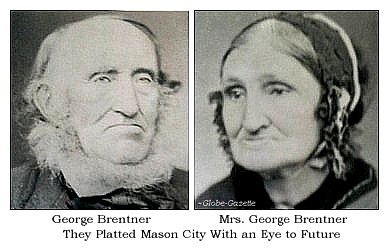
[Section 7, Page 6] When George Brentner and John B. Long laid out the first plat of Mason City in 1855, they had an eye to the future. It wasn't to be a one-street town. The two men with their wives, Anna Long and Julian Brentner, set aside a "public square" (Central Park) for the people of Mason City. There was no stipulation connected with this site. On the other hand "block 26," present [1953] site of the school administration building, was given to the people of the county on condition that a courthouse be erected on the site. It was an inducement to get the county seat for Mason City. The two families divided the town sites between them, Brentner taking those west of Federal and Long, east of Federal. The unschooled Brentner, who had come to America as a stowaway from Germany, had arrived in Mason City with a pocket full of nuggets from the gold fields of California. He sought the partnership of the educated Long in the platting of the new town. The plat was prepared June 28 and 29, 1855, and surveyed by Irvin W. Clark, county surveyor. The instrument was acknowledged before John L. McMillin, justice of the peace of Cerro Gordo County, Aug. 31, 1855, filed on the following Nov. 9 and recorded in plat book A, pages 2, 3, 4, and 5. On this plat the present Federal avenue was called St. John's; Washington was Solomon street; Adams, Clark street; and Jefferson, Wall street. State street was designated the main east and west thoroughfare and is the only street that still carries the original name. The plat extended from what is now 2nd south, to 4th north, west to Jefferson and east along State to Georgia. Meanwhile McMillin and Long assumed the leadership in the organization of the county. At that time the state law provided that any unorganized county could petition the county judge of the nearest county and be attached thereto as a civil township. In response to such a petition John M. Hunt, Floyd County judge, called for an election to be held at the McMillin store the first Monday in April, 1855. At this election McMillin and George L. Bunce were elected justices of peace. Shortly afterwards a petition for organization of the county of Cerro Gordo was presented to the Floyd county judge. The petition was granted and an order issued for the election of county officers Aug. 7, 1855. McMillin and Long called a convention at the McMillin store for nominations. Fifty-four voters cast their ballots at this election, also held at the McMillin cabin store, electing Long, county judge; Henry Martin, clerk of court; C. B. Raymond, prosecuting attorney; Henry Van Potter, treasurer and recorder; David Wright, school fund commissioner; I. W. Card, surveyor; N[athan]. W. Stackhouse, sheriff; and James Dickirson, the first settler in the county, coroner. All except Henry Martin were democrats. Shortly after this election Judge Samuel Murdock of the district court, appointed three commissioners to locate the Cerro Gordo county seat. These commissioners, all from Floyd County, decided favorably for Mason City and drove the county seat stake on the previously designated county courthouse square, set aside by Long. This action made residents in the west part of the county indignant and a committee made up of Thomas Drummond, Marcus Tuttle, Silas Card and I. W. Card appeared before the sixth general assembly at Iowa City, which convened in December, 1856, with a petition asking the appointment of three new commissioners to relocate the county seat. They were successful in their efforts and before the close of the session, Stephen H. Henderson, Mitchell County; James Taggert, Benton County; and George McCoy were appointed commissioners to relocate the county seat. This commission met at Clear Lake April 29, 1857, and selected Livonia, a site on the east edge of Clear Lake and in the northwestern corner of section 18 in Lake Township, as the county seat. During the summer of 1857 a courthouse was erected on the new site and late in the fall some of the county records were moved from Mason City to the new county seat, but most county officials were reluctant about moving. On Feb. 1, 1858, the county court convened in Mason City with County Judge J. S. Church presiding. It was immediately adjourned to meet at Livonia, where it convened and began the transaction of business. Among matters before the court was a petition presented by A. B. Miller, asking the judge to set an election in April, 1858, to submit to the voters of the county this question: "Shall the county seat of Cerro Gordo County be removed from Livonia to Mason City?" The election was held, following a heated campaign, with Mason City winning 155 to 48. The county records were brought back to Mason City where they have since remained. The ghosts of this bitterly fought election were to rise again. In 1939 the west part of the county defeated a project to build a new courthouse in Mason City. On Sept. 5, 1855, a postoffice was established here, with the town taking the name of Masonville, with Charles Lutz as the first postmaster. By a happy coincidence, it was discovered that another postoffice in the state had that name, so on Nov. 21, 1855, the name of Mason City was adopted and Lutz again named postmaster. The name, Mason City, preserved the original intent of the first settlers that the town be named after the Masonic Order, of which most of them were members. Records reveal that the notorial seal of John B. Long as judge has inscribed the Masonic emblem. Streets were given Masonic names.
The first wedding ceremony had been performed the year before Long as county judge. The contracting parties were William Wilson and Miss Abigail Gardner. The first death was that of Mrs. James Stewart, wife of Mason City's first photographer, who had recently arrived. The first birth was that of a daughter to Mr. and Mrs. Alfonzo Garner. Thus life, with its triumphs and defeats, went on in the new community. But other events of greater importance were in the process. In 1857 over expansion of railroading and other business in the west brought a panic that was felt even in the far inland prairie towns. It was to leave its mark for decades to follow. It cast a dark shadow over the lives of the Mason City pioneers. In 1857 John B. Long and with him George Brentner, gave to Paul Felt a deed for all of what was then Mason City, which had not been sold in lots, for $8,000. Felt replatted the city, enlarging it considerably. In this plat the public square was given for the second time to the city. The block set aside for a courthouse was claimed by Felt for the reason that the county seat was then in Livonia. On his plat, it was designated as "courthouse square." Felt renamed all the streets except State. Federal became Commercial and avenues to the west were named after presidents, in the following order: Washington, Adams, Madison and Jefferson. The avenues to the east were named in the following order: Michigan, Superior, College and Cedar. East and west streets were numbered from the south, starting with 1st on 5th, south, and extending to 6th, north, which was 11th street. On filing his plat of Mason City Sept. 18, 1857, Paul Felt owned, besides all of Mason City, several thousand acres of land in the county. Money was plentiful in the boomtime before the panic bubble burst. He went to Buffalo, N. Y., immediately after the replatting and began negotiations for trading his holdings here for Buffalo property. The deal was reported to involve $50,000. The papers were drawn up ready to sign when the panic struck, bringing with it the closing of many banks. The deal was never concluded. Felt had borrowed money to buy his Mason City holdings. With panic came his financial ruin and the ruin of others who had signed notes for him. Felt's holdings were sold at sheriff's sales to satisfy judgments against him. When Felt, Brentner, Long and others realized what threatened them, they laid plans to stave off the unhappy day. The property was first deeded to George Brentner, then Brentner deeded it to Charles Huntley, who went to the Civil War and was killed in battle. It was not until 1865 that the matter came up for hearing with a great lawsuit that was the talk of the country. The suit was brought against Felt and others by the eastern men who had advanced the money. The court set aside the deeds transferring the town to Brentner and Huntley. So judgments were entered against almost every piece of real estate in Mason City and all were sold at sheriff's sale. Among the properties sold was the "courthouse square," which the school system was to acquire later. But that is another story. Datus Coon established his Cerro Gordo Press (the first newspaper in Cerro Gordo County) in Mason City just in time to print the sad record of the effect of the panic. The press for July 31, 1858, had 14 columns of delinquent taxes with 176 in each column, or 2,464 titles altogehter - most of them under the heading of "owner unknown." Under these circumstances it is no wonder that Long's retail business was closed out by his creditors and that Sheriff N. W. Stackhouse advertised that he would hold a sheriff's sale of the goods at the front door of the house on the 8th of August, 1858.
Thus was crushed the last financial hope of cultured and educated John B. Long, who made such an auspicious beginning and contributed so much to the new community. The pioneers, in conquering the prairie had themselves been humbled. Long left not long afterwards and made his home in Missouri and later Arkansas, but not before being tried by a jury and acquitted on a charge of malfeasance in office. George Brentner, Long's associate, continued to live in Mason City, where his descendants became an important part in the community life.
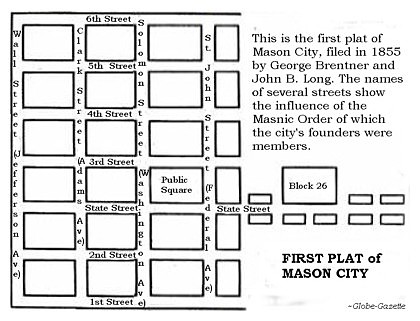
NOTE: George Brentner was born in 1804, Worms, Germany, came to America at the age of 13 years as a stowaway, arrived in
Cerro Gordo County with family member John B. Long from Rockford, Illinois, in 1884, and died at the age of 81 years on
April 9, 1885, Mason City. His wife Julia Ann (Printz) Brentner was born in Virginia April 6, 1806, and died
in Mason City April 3, 1879. They were interred at Elmwood-St. Joseph Cemetery.
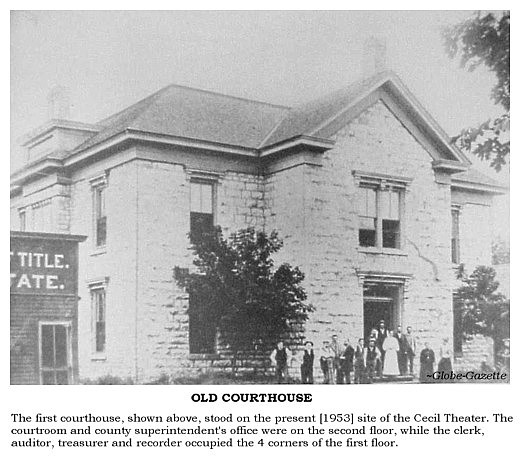
By 1890 the county business had outgrown the old courthouse west of the park and agitation started for a new building. Not until 1899, however, was the courthouse, which now [1953] serves the county, erected. That the present courthouse site was selected for the building is an interesting part of the record. This half block was acquired by the county in June, 1858, from George Brentner at a time when the supervisors apparently believed that the county had forfeited its right to the "courthouse square" (block 26) originally given the county for that purpose. On Sept. 7, 1880, the supervisors proposed bonding the county for $30,000 to build a new courthouse. Voters snowed this proposition under by 1,314 to 653 at an election on Nov. 2, 1880. Upon being convinced the courthouse vaults were inadequate and that space was insufficient for county offices, the board of supervisors on Sept. 5, 1881, decided to submit to the voters on Oct.11, 1881, the proposition: "That the sum of $20,000 be raised by taxation for the purpose of erecting a suitable courthouse." This lost by a vote of 840 to 447. Judge J. W. Ruddick of the district court bench then called the attention of the grand jury to the "delapidated condition of the courthouse and insecurity of the records and public documents of the county now in the rooms and vault of the courthouse." The same complaint was to be heard again 50 years later after another courthouse had been built. The grand jury urged the supervisors to call an election to raise $25,000 for a new courthouse. The supervisors set the election for June 7, 1882, when the proposition lost by a larger margin than ever, 1,453 to 421. Finally on Nov. 7, 1899, the county was in a mood for a new courthouse and voted 1,777 to 1,260 to erect at $64,000 building of Bedford stone. This is the courthouse that still [1953] serves the county, which now is inadequate for the needs of county officers.
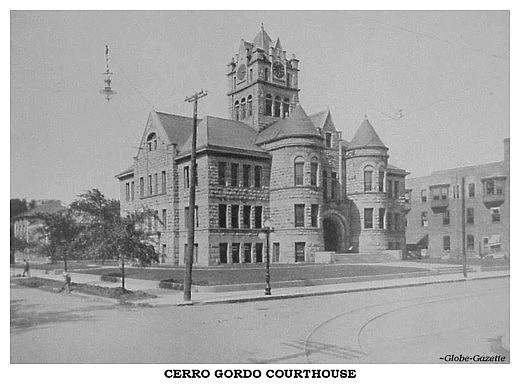
It featured turrets and a tall clock tower. This building served Cerro Gordo County until 1960
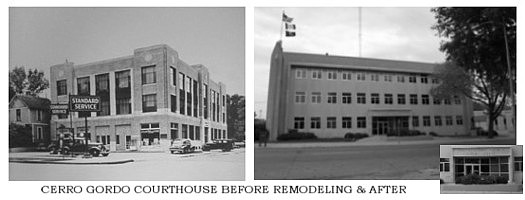
Transcription by Sharon R. Becker, December of 2014
|
Return to Cerro Gordo History Index Page
Return to Cerro Gordo Home Page